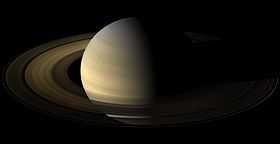Saturn's moons in fiction
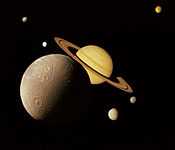
Several of Saturn's natural satellites have figured prominently in works of science fiction.
Saturnian system
Some works of fiction refer to several of Saturn's moons, or to no specific moon.
- Animorphs novel series. The creature called the Veleek was originally found by the Yeerks on one of Saturn's moons.
- Exosquad animated TV series. Saturn's moons initially were home of the Pirate Clans before the discovery of the planet Chaos.
- The Warhammer 40,000 game universe (1987-) places the headquarters and other facilities of the Ordo Malleus branch of Inquisition in Saturn's moons, including the main base of their most famous subordinates — the Grey Knights chapter of Space Marines.
- Starhunter 2300 Canadian sci-fi TV series. Many episodes of this series take place in part of the Saturn system, designated as "Saturn Federation." The spaceship carrying the main characters is the Trans-Utopian, which travels frequently between Saturn, Jupiter and Mars. Various moons of Saturn are mentioned, including Titan and Iapetus. There is also a large space station orbiting Saturn at which the Trans-Utopian docks, called "Ring-Shepherd."
- In the novel The True Meaning of Smekday, the Boov, after leaving Earth, colonize one of Saturn's moons. It is "a bit of a fixer-upper", though.
- The Daedalus Series, by Michael J. Martinez, including novels The Daedalus Incident (2013),[1] The Enceladus Crisis (2014),[2] and The Venusian Gambit (2015), incorporate an advanced civilization native to the Saturnian rings and moons, especially Titan, Mimas, and Enceladus. In the books, Saturn is referred to as Great Xanath.
Janus

Janus is a small inner moon of Saturn notable for having an orbit nearly identical to the orbit of the moon Epimetheus; the two swap orbital positions every four years.
- Janus features prominently in Alastair Reynolds' science fiction novel Pushing Ice (2005). In the novel, Janus is revealed to be a shell containing an extraterrestrial spacecraft which unexpectedly departs the solar system in the direction of a giant structure orbiting the star Spica. The novel tells the story of the crew of a human mining ship who establish a colony on the moon as it leaves the solar system.
Mimas
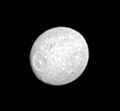
Mimas is a small, icy moon orbiting close to Saturn, notable for being scarred by Herschel crater, whose diameter is very wide compared to the total circumference of the moon.
- In Isaac Asimov's 1958 novel Lucky Starr and the Rings of Saturn the hero, knowing that Mimas is almost entirely made of ice, guides his ship on a collision course towards it, melts its surface with his weapons, and thus hides the ship in order to escape from his enemies, the people from the Sirius System.
- In "Zero Summer," a short story by Caitlín R. Kiernan, Mimas is the destination of a starship manned by two androids.
- Mimas is a recurring location in the Red Dwarf TV sitcom and its spinoff novels. In the episode "Dimension Jump", Mimas hosts a Space Corps test base for test pilot Arnold J. 'Ace' Rimmer, while the first novel, Infinity Welcomes Careful Drivers, begins with Dave Lister stranded in a seedy city on Mimas. Both the book and the series refer to the local delicacy "Mimean Bladderfish".
- "The First Duty" (1992), episode of Star Trek: The Next Generation. Mimas is the site of an evacuation station to which four Starfleet cadets, including Wesley Crusher, transport after their vessels collide.
- In Grant Callin's science fiction novel Saturnalia, Mimas is one of the locations of an alien artifact. It is also the site of human colonization and mining called "M-Base".
- In the table-top science fiction game Warhammer 40,000, Mimas serves as a high-security prison for the most dangerous prisoners of the Ordo Malleus branch of the Inquisition.
- In Paul J. McAuley's The Quiet War (2008), Mimas is home to a notable "Outer" family which has profound influence over Jovian/Saturnian satellite politics.
- In Harry Turtledove's short story Les Mortes d'Arthur (1985), Herschel crater (named Arthur in the story) is the site of the terrestrial part of the sixty-sixth Olympic Winter Games (2194) and the setting of a murder mystery.
- In Kerbal space program Minmus, an icy moon has been named after Mimas.
Enceladus
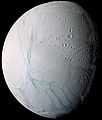
Enceladus is a small, icy moon orbiting close to Saturn, notable for its extremely bright surface and the geyser-like plumes of ice and water vapor that erupt from its southern polar region. It is the source of material for Saturn's E Ring.
- In the 1930s Buck Rogers old time radio show, Enceladus makes an appearance. In the story entitled "Killer Kane and Ardala on Saturn's moon," the titular villains try to take over the peaceful government of the Saturnian moon. The moon is depicted as having an atmosphere and supporting a happy population of humanoid life. Buck races to the moon to set things right.
- In Exosquad, Enceladus was the location of a heavily fortified Pirate Clans' outpost and the site of the second battle between them and the Exofleet just prior to the beginning of the Terran-Neosapien war.
- In Grant D. Callin's science fiction novel Saturnalia, Enceladus is one of the locations of an alien artifact.
- At the conclusion of the Time Machine book The Rings of Saturn (set in 2085), the spacecraft blows up Enceladus as it returns to Earth after meeting an alien life-form.
- In Charles Pellegrino's Dust, the narrative switches periodically to a robotic probe landing on Enceladus in search of life.
- In Paul J. McAuley's The Quiet War (2008), Enceladus serves as one of the battlefields as Earth invades Saturn's inhabited satellites in the 23rd Century.
- The History Channel show Life After People: The Series, depicts the Cassini spacecraft crashing into it and causing the bacteria on the craft to begin to inhabit it, eventually evolving into extraterrestrial life.
- In the Saturday Morning Breakfast Cereal web comic (#1733), Enceladus is depicted as having fish like creatures below its icy surface. These creatures are used in what appears to be the McDonald's Fish Fillet.
- In the GURPS sourcebook GURPS Space: Terradyne, the Terradyne corporation detonates a nuclear explosion on Enceladus to alter its orbit to eventually impact Mars, as part of its Martian terraforming project.
- In the Futurama episode Cold Warriors, Enceladus is referred to as "Saturn's main dump moon", and is the location of a specimen of the cold virus from the 20th century.
- The Yamato stops at Enceladus in the fourth episode of Space Battleship Yamato 2199 to acquire a rare metal for essential repairs, and to find possible survivors transmitting a distress signal. Isolated Yamato crew members are pursued by enemy forces, but are saved by an ice geyser.
- In Kim Stanley Robinson's novel 2312, characters occasionally refer to the 'Enceladian biota' - microscopic alien organisms that some humans ingest, believing them to have medicinal value.
- Michael J. Martinez's novel 'The Enceladus Crisis' is set in part on Enceladus.
Tethys

Tethys is a medium-sized icy moon orbiting close to Saturn, very similar to Dione.
- An unnamed Tethys is the setting for the 1980 science fiction thriller Saturn 3.
- In the American animated television series Exosquad, Tethys was the primary base of the Pirate Clans prior to the discovery of Chaos.
- Level 17 of the computer game Descent takes place in the Tethys H2O Mine.
- In Warhammer 40,000, Tethys is the location of the Librarium Daemonicum, a repositary of the knowledge of the Ordo Malleus branch of the Inquisition.
Dione
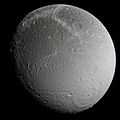
Dione is a medium-sized icy moon orbiting close to Saturn
- In Grant D. Callin's science fiction novel Saturnalia, Dione is one of the locations of an alien artifact.
- In the early Noon Universe novel Space Apprentice by Strugatsky brothers as the heroes stop there on their way (one of them is a planetologist and has some interest in the moon's observatory) they found that its administrator made it a living hell for everybody. This revelation serves as one of the major plot points in the novel.
- In Paul J. McAuley's The Quiet War (2008), Dione's Paris is the leading settlement amongst Saturn's inhabited "Outer" satellite colonies, and suffers heavily due to its vocal resistance.
- In Kim Stanley Robinson's 2312, Dione has been broken into chunks and crashed onto the surface of Venus as part of a terraforming process.
Rhea
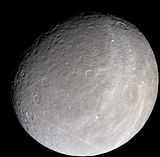
Rhea is the second-largest moon of Saturn.
- "Valley of Pretenders" by Dennis Clive (pseudonym of John Russell Fearn), published in Science Fiction, March 1939.
- "Outpost of the Eons" by Dirk Wylie (pseudonym of Joseph Harold Dockweiler), published in Astonishing Stories, April 1943.
Titan
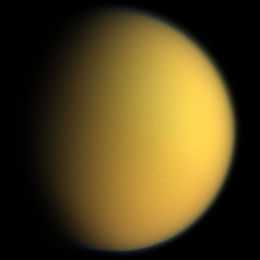
Titan is the largest moon of Saturn. Its substantial atmosphere makes it the most Earth-like moon in the Solar System and hence a popular science fiction setting.
Hyperion
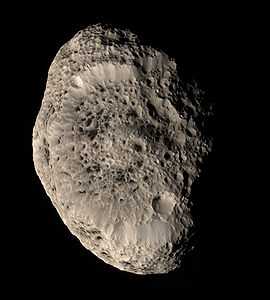
Hyperion is the largest irregularly-shaped moon of Saturn, orbiting between Titan and Iapetus.
- Level 16 of the computer game Descent takes place in a methane mine on Hyperion.
- In Dan Simmons's Hyperion, the eponymous planet was first colonised by settlers from a colony on the moon Hyperion.
Iapetus
Iapetus is a large moon orbiting further from Saturn than any of its other large satellites. Half of its surface is very bright while the other half is extremely dark. Investigations since 2004 have also noted its irregular shape, immense impact basins, and a high mountainous ridge on the equator.
- In Theodore Sturgeon's short story "The Comedian's Children" (1958), a manned expedition to Iapetus in 2034 creates a public craze for black/white designs and "bi-colored gimcrackery", but is later linked to iapetitis, a disease in children where one side of the body turns white and paralyzed, the other black.
- In Arthur C. Clarke's novel 2001: A Space Odyssey (1968), astronaut Dave Bowman finds an enigmatic alien monolith waiting for him on the surface of Iapetus (referred to as "Japetus" throughout). Iapetus's two tone coloration is caused by a vast white ellipse on the moon's surface, with the monolith appearing as a black dot in its exact center. When the Voyager space probes arrived at Iapetus thirteen years later, they discovered that there was indeed a black region within the moon's brighter hemisphere. Clarke reports that Carl Sagan, who was on the Voyager imaging team, sent him a photo, with the note "Thinking of you ...".[3] Because of difficulties achieving a convincing model of Saturn's rings, the sequels and film version of 2001: A Space Odyssey relocated the monolith to an orbit around Jupiter.
- Iapetus is the setting for The Saturn Game (1981) by Poul Anderson.
- Iapetus is the second site of the mysterious phenomenon called "goorm" in Sergei Pavlov's hard SF novel Moon Rainbow (1984), first being the Uranus' moon Oberon.
- In Kim Stanley Robinson's futuristic novel The Memory of Whiteness (1985), Iapetus is populated by the descendants of Soviet colonists who retain a Communist political system.
- In Grant Callin's 1986 science fiction novel Saturnalia, Iapetus is one of the locations of an alien artifact. There is also human colonization and mining at an installation called "I-Base".
- In John Varley's Gaea trilogy, Iapetus is used as a "nest" for a fledgling Titan. One of the objectives of the Ringmaster mission to Saturn is to investigate the moon's dark region recently contracting to a narrow band; Gaea reveals this is the result of her offspring entering a new stage of development. When it is fully mature, Iapetus will be shattered and the new Titan born out of its rubble.
- In David Weber's novel The Armageddon Inheritance (1993), genocidal aliens (the Achuultani) attempt to use Iapetus as a kinetic energy weapon to destroy all life on Earth.
- In the Warhammer 40,000 universe, Iapetus acts as a dockyard for the Ordo Malleus fleet, as well as that of the Grey Knights chapter of Space Marines.
- Iapetus appears in Ian McDonald's Chaga.
- In Jack McDevitt's The Engines of God (1996), there is a strange ice-made icon on Iapetus. It leads to a depressing discovery that every intelligent civilization of the Galaxy could be obliterated by an unknown Dark Force from the void between Galaxy's arms.
- Iapetus is the setting of the book Aliens: Steel Egg by John Shirley (2007).
- In Kim Stanley Robinson's novel 2312, a giant city known as the High Street is built along the spine of Iapetus's equatorial ridge.
- In the online comic by Joshua Quagmire, "Bunz & Katz" (Nov 2012 - current) Iapetus is revealed to be an ancient, near-derelict alien battle station which is "awakened" by the Cassini probe fly-by. The series' protagonists are the only surviving scouts from this station.
Phoebe
Phoebe is a retrograde orbiting moon in the outer Saturn system. It is the largest of the Saturnian irregular moons.
- In James S.A. Corey's Expanse series, Phoebe is actually an alien biological warhead that was accidentally captured by Saturn on its way to reprogram protozoan life on Earth. The extraction and use as a weapon of the protomolecular payload of Phoebe drives the primary conflicts of the series. After the protomolecule is used against Eros, Phoebe is destroyed via thermonuclear bombardment by the Martian space navy to keep anyone else from obtaining samples, and to prevent it from getting loose in the system.
Notes
- ↑ Martinez, Michael J. (August 2013). The Deadalus Incident. New York: Night Shade Books. ISBN 978-1597804721.
- ↑ Martinez, Michael J. (May 2014). The Enceladus Incident. New York: Night Shade Books. ISBN 978-1597805049.
- ↑ Arthur C. Clarke, Introduction to 2010: Odyssey Two (1984)
| ||||||||||||||||||||||||
| ||||||||||||||||||||
